Intel Core i9-10850K Review: The Real Intel Flagship
by Dr. Ian Cutress on January 4, 2021 9:00 AM EST- Posted in
- CPUs
- Intel
- Core
- Z490
- 10th Gen Core
- Comet Lake
- LGA1200
- i9-10850K
CPU Tests: Simulation
Simulation and Science have a lot of overlap in the benchmarking world, however for this distinction we’re separating into two segments mostly based on the utility of the resulting data. The benchmarks that fall under Science have a distinct use for the data they output – in our Simulation section, these act more like synthetics but at some level are still trying to simulate a given environment.
DigiCortex v1.35: link
DigiCortex is a pet project for the visualization of neuron and synapse activity in the brain. The software comes with a variety of benchmark modes, and we take the small benchmark which runs a 32k neuron/1.8B synapse simulation, similar to a small slug.
The results on the output are given as a fraction of whether the system can simulate in real-time, so anything above a value of one is suitable for real-time work. The benchmark offers a 'no firing synapse' mode, which in essence detects DRAM and bus speed, however we take the firing mode which adds CPU work with every firing.
The software originally shipped with a benchmark that recorded the first few cycles and output a result. So while fast multi-threaded processors this made the benchmark last less than a few seconds, slow dual-core processors could be running for almost an hour. There is also the issue of DigiCortex starting with a base neuron/synapse map in ‘off mode’, giving a high result in the first few cycles as none of the nodes are currently active. We found that the performance settles down into a steady state after a while (when the model is actively in use), so we asked the author to allow for a ‘warm-up’ phase and for the benchmark to be the average over a second sample time.
For our test, we give the benchmark 20000 cycles to warm up and then take the data over the next 10000 cycles seconds for the test – on a modern processor this takes 30 seconds and 150 seconds respectively. This is then repeated a minimum of 10 times, with the first three results rejected. Results are shown as a multiple of real-time calculation.
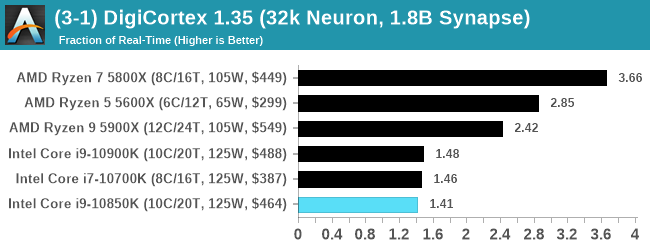
The wide variation on AMD seems to prefer high-core-count single chiplet processors. Intel is taking a back seat here, as it is also using slower memory.
Dwarf Fortress 0.44.12: Link
Another long standing request for our benchmark suite has been Dwarf Fortress, a popular management/roguelike indie video game, first launched in 2006 and still being regularly updated today, aiming for a Steam launch sometime in the future.
Emulating the ASCII interfaces of old, this title is a rather complex beast, which can generate environments subject to millennia of rule, famous faces, peasants, and key historical figures and events. The further you get into the game, depending on the size of the world, the slower it becomes as it has to simulate more famous people, more world events, and the natural way that humanoid creatures take over an environment. Like some kind of virus.
For our test we’re using DFMark. DFMark is a benchmark built by vorsgren on the Bay12Forums that gives two different modes built on DFHack: world generation and embark. These tests can be configured, but range anywhere from 3 minutes to several hours. After analyzing the test, we ended up going for three different world generation sizes:
- Small, a 65x65 world with 250 years, 10 civilizations and 4 megabeasts
- Medium, a 127x127 world with 550 years, 10 civilizations and 4 megabeasts
- Large, a 257x257 world with 550 years, 40 civilizations and 10 megabeasts
DFMark outputs the time to run any given test, so this is what we use for the output. We loop the small test for as many times possible in 10 minutes, the medium test for as many times in 30 minutes, and the large test for as many times in an hour.
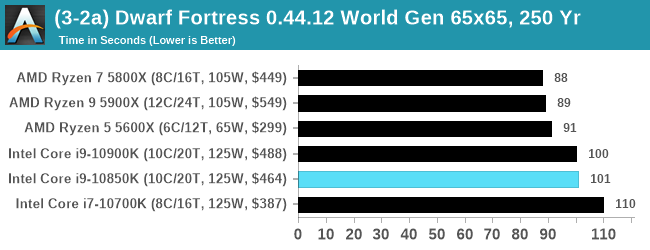
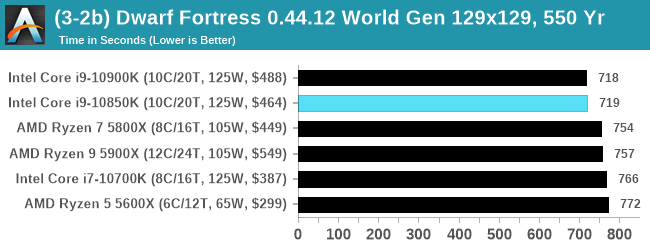
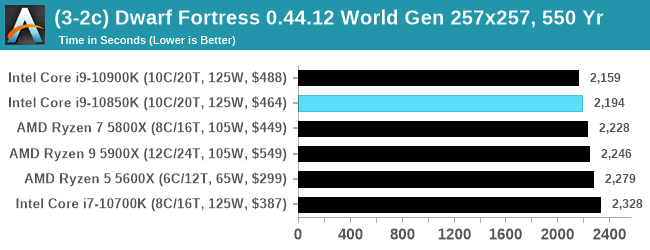
Dolphin v5.0 Emulation: Link
Many emulators are often bound by single thread CPU performance, and general reports tended to suggest that Haswell provided a significant boost to emulator performance. This benchmark runs a Wii program that ray traces a complex 3D scene inside the Dolphin Wii emulator. Performance on this benchmark is a good proxy of the speed of Dolphin CPU emulation, which is an intensive single core task using most aspects of a CPU. Results are given in seconds, where the Wii itself scores 1051 seconds.
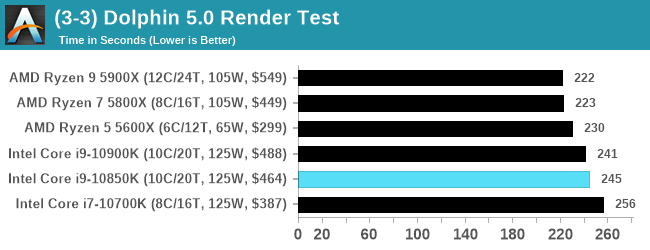












126 Comments
View All Comments
Cullinaire - Monday, January 4, 2021 - link
Shades of Prescott?😆
Crazyeyeskillah - Tuesday, January 5, 2021 - link
i used to own a PresHottTheinsanegamerN - Tuesday, January 5, 2021 - link
I’d rather PresNotGeoffreyA - Wednesday, January 6, 2021 - link
Somewhat reminiscent.BGADK - Monday, January 4, 2021 - link
Thank you for an interesting article.Availability of Intel CPU's obviously varies a lot across regions. Here in Denmark there is ample supply of the i9-10900K, which is prices 60 euros higher than the i9-10850K. Is it worth it? Before I read the article I would have said "Probably not", but the lower temperatures definitely makes paying a bit more for at better binned CPU a reasonable proposition.
Betabacker - Monday, January 4, 2021 - link
I purchased a 10850k for $380 from BH Photo a couple of months ago. I have a Kraken x73 on it with thermal grizzly paste. I still can't overclock or it'll cook everything. Temps can jump 20 degrees instantly.Nirkon - Tuesday, January 5, 2021 - link
I also bought this CPU but a few weeks ago for that price as well, still waiting for it to arrive though, but I think at that price point there is no better option at the moment, not only because AMD isn't in stock but if you are not using it exclusively for gaming it will for sure offer better future performance at 10c/20t than 6c/12tceomrman - Tuesday, January 5, 2021 - link
I think a lot of people are forgetting how important it is for a vendor to have products to sell. Ryzen 3 can whup Comet Lake on benchmarks all day, but Newegg has exactly zero 5000-series CPUs in stock while they'll ship a 10850k right now for $430. In reality, that means the AMD competition is the 3800X ($417) / 3700X ($325). Those are cheaper, more efficient, and run cooler, but they are also definitely slower (10-15%) at most tasks. The significantly more expensive 3900X ($543) is a step above on many computational tasks and would be my personal choice, but it's still slower than the 10850k at gaming. Buyers don't love getting 2019's leftovers at or above launch MSRP, either, even if they are actually still a good value. That's why it looks like Intel has a good product for its needs. Gamers are likely to choose the Intel CPU, as are some less-hardcore enthusiasts who don't want to wait for current-gen tech. Once AMD stocks the shelves with Zen 3, Intel will have to do better. Until then, it's hard to say a product that you can't buy is better than one you can.Qasar - Tuesday, January 5, 2021 - link
or, one can just be patient, and wait.no one i know who playes games, and is looking for an upgrade is even considering intel now. their current system is fine, so they will be waiting till zen 3 is instock and upgrade then.
gregerst - Tuesday, January 5, 2021 - link
During the course of four or five years of using a 5900x, it would pay for itself many times over by using less electricity vs 10850K. Even the 10900K would make up the price difference over the 10850K. Maybe Intel owns stock in power companies? :D